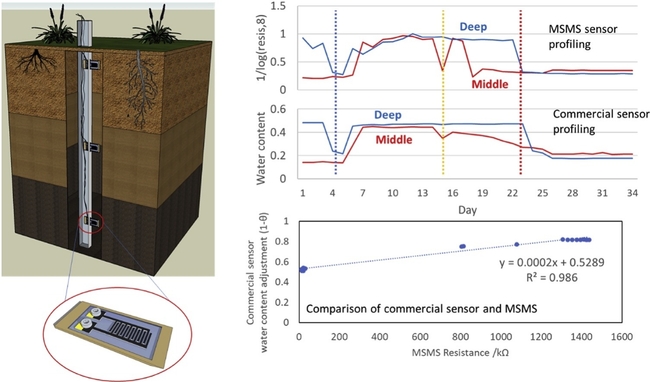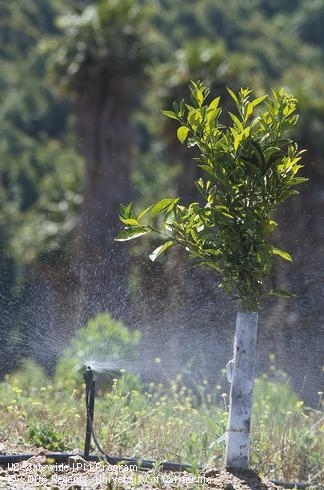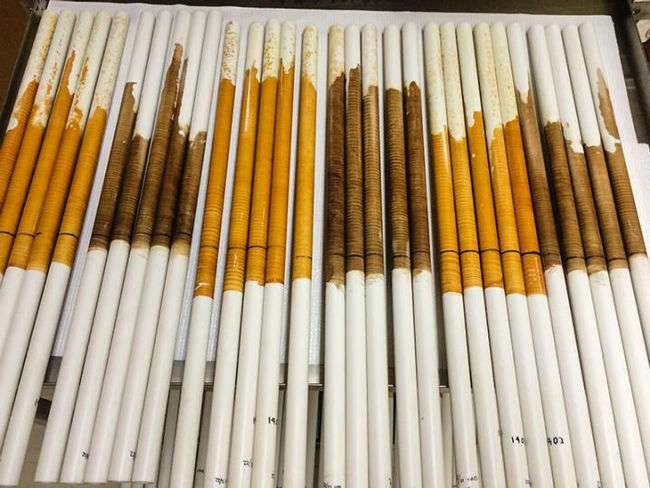
Posts Tagged: soil moisture
On the Soil Fringe
Solving the mysteries of water and air underground
IMAGE: PVC pipes painted with rust, known as IRIS tubes, help track how much oxygen is in the soil. When there isn't enough oxygen, microbes will turn the rust into regular... view more
Credit: J.C. Fiola
Stand outside and look underneath your feet. There, perhaps under some grass, is the soil. On a dry day, all the spaces in the soil are filled with air. And some distance further down, those spaces are entirely water. So, what's in between?
That's the capillary fringe. And it might just be the most important -- and mysterious -- thing you've never heard of.
Like a paper towel wicking up water from a surface, water rises above its natural level in soils through capillary action. A lot of chemical and microbial activity in the soil varies based on how much water or air is around. So, the capillary fringe controls many important functions in the soil.
"Important processes like contaminant breakdown and carbon storage depend on the amount of water and oxygen available," says Jaclyn Fiola, now a graduate student at Virginia Tech. "Understanding the conditions in the capillary fringe will help us predict where certain soil processes will occur."
Fiola and her team set out to better understand this strange region. But that's no easy feat. With the entire fringe underground, it's invisible. And even scientists have a hard time agreeing on where the fringe begins and ends. That's where lab experiments come in handy.
The team gathered two kinds of soil, one sandy and one loamy. The scientists packed this soil into five-gallon buckets with holes near the bottom to allow water to enter.
To track the key events in the capillary fringe, Fiola turned to cleverly simple systems. To study how much oxygen was in the soil, the researchers painted PVC pipes with rust-embedded paint. They inserted these pipes into the soil.
Wherever there wasn't enough oxygen, microbes would "breathe" rust instead. That would turn the rust into a different form of iron, which washes away. By measuring how much rust was left, the team could get a glimpse beneath the soil.
The researchers were surprised to find that the water rose the entire height of the buckets in both types of soils. That means the capillary fringe extended at least 9 inches, more than they were expecting.
They were also surprised that the PVC pipes had lost their rust well above the water table. "This means the soil in the capillary fringe at least 2 inches above the water table is behaving like soil in the water table even though it's not fully saturated," says Fiola.
"Based on the findings, the soil directly above the water table behaves a lot like the saturated soil within the water table," says Fiola.
Wetlands are defined by the government as soils that are saturated near the surface. But if soils act like they're saturated even above the water table, that means more areas might act like wetlands and deserve protection.
Scientists also wanted to better understand how water and air in the capillary fringe can affect other soil processes. To track decomposition, they inserted wooden sticks into the soil. Researchers found that microbes eating the wooden sticks were finnicky.
"Our results suggest that the microbes that carry out decomposition require ideal conditions - not too wet and not too dry," says Fiola. The wood was most eaten away in the middle of the buckets where it was moist.
"The capillary fringe is far too complicated to define based on one single measurement," says Fiola. Even though her team measured many different aspects of the fringe, those measurements didn't always agree with one another.
Soils are complex, especially outside of the lab. So now the researchers are planning to study the capillary fringe in more realistic conditions and in the field.
That future work might give us a better understanding of -- and appreciation for -- the fuzzy, complex, and vital in-between spaces beneath our feet.

soil core
Soil Health Webinar
The University of California Cooperative Extension San Diego County presents:
The Climate Action & Agriculture Symposium Webinar:
Soil Health
The health and safety of our communities is a priority. Due to Coronavirus disease 2019(COVID-19), the UC Cooperative Extension is hosting a FREE webinar in lieu of the day-long event as previously announced.
Thursday, May 21,2020
1:00pm–3:30pm|FREE: Registration Required
Description:
The Climate Action and Agriculture Symposium focuses on the policies, research, programs, strategies and resources needed to support sustainable agriculture and the reduction of greenhouse gas emissions via the unique agricultural environments and industry in San Diego County.This symposium is intended to bring together agricultural producers, policy makers, government agencies, researchers, educators, consultants and other public and private agricultural service providers.
Presentations:
Climate Trends & Impacts to Agriculture
Tapan Pathak, Ph.D., UCANR Specialist,Climate Adaptation in Agriculture
Integrated Soil Management
Joji Muramoto, Ph.D., UC ANR Specialist, Organic Production
Mulching and Cover Crop Strategies: Avocados and Other Orchard Crops
Ben Faber, Ph.D., UCCE Farm Advisor
Cover Crop Strategies: Vegetables
Oli Bachie, Ph.D., UCCE County Director-Imperial & Farm Advisor
Spadra Farm Healthy Soils Program Research and Demonstration Project
TBA- Agriculture & Plant Science Departments, California State Polytechnic University, Pomona
Opening Remarks by Hannah Gbeh,
Executive Director, San Diego County Farm Bureau
Lightening Talk Session:
Brief updates on recent and current climate and agriculture projects.
TALKS INCLUDE:
CDFA/UC ANR Healthy Soils Program, County of San Diego Compost & Mulch Market Study, Climate Science Alliance 2020 Climate Change Consortium for Specialty Crops, San Diego Food System Alliance Food Vision 2030,and more.
Jan Gonzales(jggonzales@ucanr.edu)
New Cheap Soil Moisture Sensor?
A team of University of Connecticut researchers engineered a soil moisture sensor that is more cost effective than anything currently available and responds to the global need to regulate water consumption in agriculture. https://today.uconn.edu/2019/09/engineers-produce-water-saving-crop-irrigation-sensor/
Designed and tested on the university's farm, the sensors are small enough to insert into the soil with ease and less expensive to manufacture than current technology, the researchers write in the Journal of Sensors and Actuators.
“Advances in hydrological science are hampered by the lack of on site soil moisture data,” said Guiling Wang, study author and professor of civil and environmental engineering at UConn. “It's really hard to monitor and measure things underground. The challenge is that the existing sensors are very expensive and the installation process is very labor intensive.”
The sensors developed by the team of UConn engineers — environmental, mechanical, and chemical — are expected to save nearly 35% of water consumption and cost far less than what exists. Current sensors that are used in a similar way range from $100 to $1,000 each, while the one developed at UConn cost $2, according to the researchers.
An alternate monitoring option, soil moisture data collected from remote sensing technology such as radars and radiometers on board satellites, have suffered from low resolution. But the new technology developed by UConn Professor Baikun Li's group can provide high spatio-temporal resolution data needed for hydrology model development in Wang's group.
In the UConn prototype, wires are connected from the sensors to an instrument that logs data. Researchers conducted field tests of the sensors — performing side-by-side tests with commercial sensors under various environmental conditions throughout a 10-month period. The effects of the environmental variations on soil moisture throughout the period were clearly reflected.
Critically, the small sensors can also be easily sent around he world given the fact that soil moisture plays a fundamental role in agricultural decision-making globally.
Accurate soil moisture sensing is essential to ensure a water level that produces the most robust crops while not wasting the natural resource. In some states in the U.S. — Florida and California, for example — irrigation water usage has become tightly restricted.
The UConn researchers are also working on a nitrogen sensor that is the same model of the water sensors. These would help provide farmers with information on when fields need fertilizing. Currently, nitrogen sensors are not available using this type of technology.
“This is really an exciting start to a much larger scope of things we have in mind,” says Li, a study author and professor of civil and environmental engineering.
Towards water-saving irrigation methodology: Field test of soil moisture profiling using flat thin mm-sized soil moisture sensors (MSMSs)
WangchiZhouaZhihengXuaDannyRossaJamesDignanbYingzhengFanaYuankaiHuangaGuilingWangaAmvrossios C.BagtzoglouaYuLeicBaikunLia
https://doi.org/10.1016/j.snb.2019.126857Get rights and content
Abstract:
This study examined flat thin mm-sized soil moisture sensors (MSMS) fabricated using thermal press technology on thin compact disc (CD) to solve the long-standing problems of soil moisture profiling. The 10-month field tests conducted at a farm site compared three groups of MSMS with commercial capacitance-type soil moisture sensors (SMS) in terms of accuracy, sensitivity to environmental variations (e.g. water shock, temperatures, dry/wet seasons) and long-term stability. MSMS sensors were mounted on the shallow, middle and deep locations of a hollow plastic rod (length: 1.1?m) and installed along the soil depth to profile the soil moisture variation. The resistance readings of MSMS sensors along soil depth were recorded in a real-time mode. Due to soil settlement over time after installation, the MSMS sensors in the shallow soil suffered from unstable readings, while the MSMS sensors in the middle and deep soil exhibited high stability and had the best correlation with water content values of commercial sensors (R2 value: 0.6264). The contact between MSMS surface and soil particles appeared to be a critical factor determining the stability of MSMS readings. In addition, MSMS sensors showed a prompt response to the sharp change of soil moisture in the water shock tests. The soil moisture profiles collected from MSMS sensors captured the spatiotemporal variation of soil moisture, which enabled the simultaneous profiling at multiple locations. This field study demonstrated the great potential of mass deployment of low-cost but accurate MSMS sensors to achieve high resolution profiling for water-saving irrigation.

soil moisture sensor photo and charts
Low-Flow Irrigation Scheduling
How to irrigate is probably the most common question in irrigated agriculture, even with 10,000 years of cultivation knowledge to guide us. The complexities of irrigation and the unique situation for each grower makes this question so difficult. Not enough water, and plants have diminished growth or the propensity for disease and disorder 1. Too much water leads to root disease and nutrient problems 2. So, it can't be too much or too little, but just right. There are times when citrus can handle a little more water stress than other times, which can lead to water savings 3, especially in a drought year or in areas where water costs are crucial. Salinity further compounds the question of irrigation where striking a balance determines the health of your tree. Staying in tune with your orchard and using appropriate methods to measure water need, water use, environmental water demand, and soil water-holding capacity will help inform irrigation management decisions.
There are all kinds of ways of estimating tree water need 4 , a valuable piece of information for irrigation decision making. An inexpensive and often overlooked method of estimating tree water requirements is grower observation in the orchard to assess leaf color, leaf size, the look of the leaves, and canopy fullness. Pure observation and knowledge of your trees yields a lot of valuable information regarding irrigation management. Beyond observation, a direct measure of the tree with a porometer, pressure gauge (bomb), sap flow meter, dendrometer or other device gives an absolute or relative number of tree performance. Technological advances, such as telemetry and imaging with drones or satellites, holds promise, but are still being perfected for general irrigation use. In general, technological devices yield informative data, but tend to be expensive, delicate, and require manual monitoring to account for tree-to-tree variation in the orchard.
Soil moisture sensors can be an effective method of evaluating water use by the tree. The most basic way to measure soil moisture is with a human powered shovel or soil tube 5. While it requires an operator who knows what they are doing, the technique is easily learned and repeatable. A human and shovel can move around an orchard checking out different suspicious spots that are not easily done with fixed-in-place sensors. Installation of soil moisture sensors systems range in cost and capabilities, yet provide specific data on water use. Integrating certain systems into communication relay systems allow for the monitoring of multiple sites at once. Some sensors can measure soil salinity, as well as soil moisture, to give a sense of whether the water in the soil will be useable by the tree. If soil moisture sensors are used, correct placement of where roots are taking up water is imperative to get an accurate assessment of water uptake. Overall, it is critical to keep the entire orchard in mind and understand that fixed sensors only take a specific location's reading.
Another great technique to inform irrigation scheduling is an estimate of the demand that drives water use. An evapotranspiration estimate either by CIMIS, a private weather station with ET-calculation or atmometer gives not only an amount to apply but also when to apply that amount based on the water holding capacity of the soil and the rooting depth of the crop. Soil moisture holding volume can be complicated, but can be estimated from the NRCS table in the previous paragraph5 or from tables in the Web Soil Survey 7.
Simply running an irrigation system for a specific amount of time and probing for depth of water penetration and extent of wetted area is the best way to get an estimate of soil moisture holding capacity. This knowledge is needed in order to decide whether the active rooting volume is getting wetted sufficiently or too much is being applied. Emitters are rated by gallons per hour, but that 1 gph, 5 gph, 20 gph emitter output might differ according to water pressure that can vary over an irrigation period. On the flip side, monitoring soil moisture depletion over time can give an approximation of how depletion compares to ET estimates. Soil moisture depletion can be measured by soil moisture sensors or by shovel and feel. This estimate of applied water compared to output and ET only needs to be done once at a given growth stage of the orchard. If the orchards is young, it will need to be done each year as the trees fill out. An estimate of canopy growth can also be used to better approximate young orchard ET.
All of these methods suppose that a grower has the capability to irrigate when, where and for how long they need to. If water delivery is on a fixed schedule and the amount of water can be controlled it is valuable to understand specific water needs. Knowing the rated applied amount of an emitter is important, but that amount shouldn't be assumed, especially considering natural wear and tear, damage from harvest, poor filtration, clogging, or damage by wildlife. Maintenance to insure good distribution uniformity is critical to the operation and the correct application of water to trees and for the maintenance of tree health. Low-pressure systems are wonderful but they should be evaluated on a yearly basis and tuned up in preparation for every irrigation season. Many growing areas have mobile irrigation labs that will evaluate system performance and make recommendations for improvement.
All said, knowing the orchard and evaluating tree health will inform irrigation management decisions. Applying technology where technology is appropriate will help. Using it to help advise irrigation decisions is valuable, but new tools will not always be the answer.
It's important to know what is being applied.
Trust but verify.
Drought Tips & Video: https://www.youtube.com/watch?v=LKSQRuHAnYA ; https://anrcatalog.ucanr.edu/pdf/8549.pdf

irrigATING CITRUS
NASA Soil Moisture Mapping
NASA's Maps of Global Soil Conditions
Are the
Future of Farming
Find water anywhere.
By Mary von Aue
The US Department of Agriculture (USDA) is now using data collected from the first NASA satellite mission dedicated to measuring the water content of soils. These maps created by the space agency will be used to monitor global croplands, make commodity forecasts, and will help the USDA forecast crops globally.
The Soil Moisture Active Passive mission, or SMAP, launched in 2015 in order to map the amount of water in soils worldwide. On Friday, NASA announced that the agency is providing the mission with new tools developed by NASA's Goddard Space Flight Center that will better predict where there could be too much or too little moisture in the soil to sustain farming.
“There's a lot of need for understanding, monitoring and forecasting crops globally,” said John Bolten, a research scientist at Goddard. “SMAP is NASA's first satellite mission devoted to soil moisture, and this is a very straightforward approach to applying that data.” NASA presents the satellite data in maps that are rendered to resemble watercolor paintings. Soils that are wetter than normal are seen in shades of greens, while those that are drier than normal are seen in shades of browns.
Before this collaboration, the USDA had used computer models that would incorporate precipitation and temperature observations to indirectly calculate soil moisture. However, this approach was prone to error in areas that lacked high-quality, ground-based instrumentation to collect the data. Now, NASA is incorporating direct SMAP data on soil moisture into Crop Explorer, the USDA's Foreign Agricultural Service website that reports on regional droughts, floods, and crop forecasts.
The SMAP viewer is still in beta but is expected to provide updated global coverage every three days once it launches. The maps will be managed for NASA's Jet Propulsion Laboratory and will provide Crop Explorer with timely updates that are essential for monitoring conditions and forecasting productivity.
This cross-agency collaboration will do more than help the USDA identify farming trends. By monitoring moisture in the soil globally, scientists can more accurately forecast conditions that could have tremendous economic and social impact.
https://www.inverse.com/amp/article/45498-nasa-maps-of-global-soil-conditions-future-of-farming
Map created with NASA's SMAP data from May 16-18, 2018

soil moisture US


